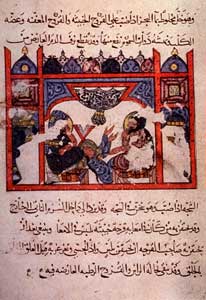National Library of Medicine (NLM) puts 175 years in the books
May / June 2011 | Volume 10, Issue 3
"We must develop a communications system so that the miraculous triumphs of modern science can be taken from the laboratory and transmitted to all in need."
~ Senator Lister Hill, 1965
It predates the birth of Freud and is the largest repository of its kind: The
National Library of Medicine (NLM) marks its 175th anniversary this year. It was founded in 1836 as the library of the U.S. Army Surgeon General and now, as part of NIH, is the world’s largest library of the health sciences and collects, organizes and makes available biomedical science information to scientists, health professionals and the public. Its electronic resources are used by millions of people around the world.
Facts about the National Library of Medicine (NLM)
- The Library has more than 17 million items in its collection, 150 languages are represented and there are more than 50 miles of bookshelves underground. NLM has a rich collection of rare and historic items. The oldest item in the Library’s collection is an 11th century Arabic manuscript (pictured below).

Image courtesy of the
National Library of Medicine,
from the collection of R. M. Riefstahl
The oldest item in the Library’s
collection is an 11th century
Arabic manuscript.
- NLM has more than 230 databases and online resources that are free, easy to access and available to anyone with Internet access. A growing number of the library’s resources are available on mobile devices.
- NLM has made it easy to find and search biomedical literature. Index Medicus, a groundbreaking index of medical journal articles first published in 1879, evolved into MEDLINE, the first marriage of online search technology and nationwide telecommunications, in 1971. In its current form,
PubMed/MEDLINE is the most frequently consulted scientific/medical database in the world.
- NLM established librarian training programs and the National Network of Libraries of Medicine in the late 1960s to equalize access to the biomedical literature between the United States - regardless of geographic location, socioeconomic status, or level of access to computers and telecommunications.
- NLM is home to the
National Center for Biotechnology Information (NCBI), established in 1988 as a national resource for molecular biology information. Today, NCBI is an indispensible international repository and software tool developer for genetic sequences and other scientific data, and a pioneer and leader in linking data and published research results to promote new scientific discoveries.
- NLM began intensive development of Web health information services for the general public in 1998 with the release of
MedlinePlus.gov. Now available in English and
Spanish, MedlinePlus is one of many NLM consumer health information products also available on mobile devices such as smartphones.
- NLM released
ClinicalTrials.gov in 2000. It is now the world’s largest source of information about clinical trials recruiting for patients and healthy volunteers, and also provides summary results of some trials long before they appear in the published literature.
- NLM began providing toxicology and environmental health data for use in emergency response and disaster management in the mid-1960s. Today, it produces information services to help health professionals, disaster information specialists, and the general public cope with emergencies and disasters.
- NLM's international partnerships strengthen and expand global access to the world's health literature. Targeting another area of opportunity, NLM played a critical role in the
Multilateral Initiative on Malaria, leading the effort to enhance Internet connectivity and access to medical literature for malaria researchers at 27 sites in 14 African countries.
Special programs and resources at NLM
NLM is marking the occasion with a number of special programs in support of its mission. Among these are symposiums on the future of clinical trials, training for journalists in the use of NLM resources and research and presentations on various grant mechanisms. Learn about NLM’s history.
NLM resources for library users and researchers
More Information
To view Adobe PDF files,
download current, free accessible plug-ins from Adobe's website.